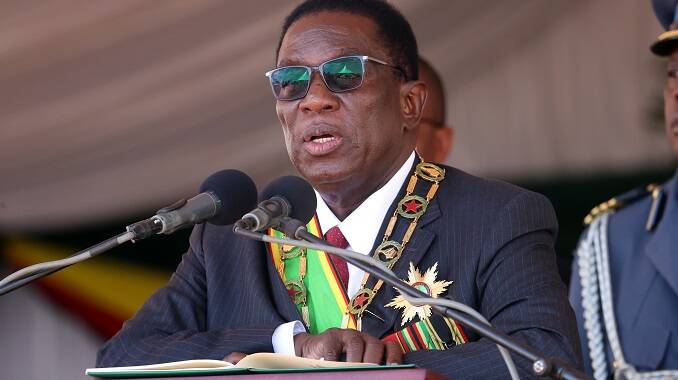
The Sunday Mail

Kuda Bwititi recently in BUHERA
THE value of goods and services produced in Zimbabwe, as measured by the gross domestic product (GDP), has shot up from US$16 billion in 2018 to over US$47 billion this year, underlining the pace of economic growth over the past five years, President Mnangagwa has said.
Zimbabwe’s economy grew by 8,5 percent in 2021 and a further 6,5 percent in 2022.
Last year, the economy is estimated to have grown by 5,5 percent.
Despite the El Niño-induced drought that affected the 2023/2024 summer cropping season, the Government expects growth to top 3,5 percent this year.
In his keynote address at the main 44th Independence Day celebrations in Buhera, Manicaland province, on Thursday, President Mnangagwa said such progress demonstrates Zimbabwe’s resilience.
“The overall economic outlook remains bright. Our country’s GDP is now exceeding US$47 billion, up from US$16 billion in 2018.
“This shows that we, the descendants of the Great Munhumutapa, are a resilient, focused, determined and hardworking people. Zimbabwe is winning.”
The President said Zimbabwe is determinedly marching to prosperity and changing the livelihoods of its people for the better.
“We, the people of this great nation, always emerge victorious. We are masters of our own destiny; a united and resilient people, the descendants of the Great Munhumutapa.
“We shall continue marching forward as one people. From Plumtree to Mutare, from Zambezi to Limpopo, we are building our country and improving our quality of life.”
Mining, he said, has significantly contributed to Zimbabwe’s growth.
“A positive growth as a result of investments from both domestic and foreign players, as well as incentives and policies, is evident in the mining sector. In the wake of recent discoveries, Zimbabwe is on course to be a player in the oil, gas and petrochemical industry.
“The country’s lithium mining and processing portfolio is growing, including here in Buhera district.
“This will see Zimbabwe sustainably exploiting this strategic new energy resource for the socio-economic development of our people. We are also contributing to addressing the global climate change crisis.”
He said capacity utilisation is also increasing in the manufacturing sector.
“New industries are being opened, with more of our young entrepreneurs now confidently producing goods and services for our country and communities.
‘‘Exports of value-added products increased by 22 percent in 2023.”
Tourism has also contributed to Zimbabwe’s GDP growth, as the sector recorded a 34 percent jump in 2023.
“The growth of the sector has been further boosted by increased domestic tourism, as more of our people enjoy independence by visiting different parts of the country. I commend Zimbabweans for this culture and pride in our local destinations and country as a whole.”
The President also underscored the growth in infrastructure development.
According to a compendium of Government projects being implemented under the National Development Strategy 1 that was released in July last year, from 2018, the Second Republic has undertaken 6 869 projects across the country.
Of this figure, 4 984 had been completed by June last year.
The infrastructure initiatives vary in scope, from community-based empowerment and strategic projects to provincial and national ones.
However, economist Mr Eddie Cross said Zimbabwe’s GDP has been understated and could actually be around US$100 billion if the informal economy is accurately evaluated.
“It is extremely difficult to determine exactly what the GDP of Zimbabwe is. Our economy is amongst the most informalised in the world, and in addition to that, we are majority dollarised, and this makes it very difficult to measure the amount of economic activity actually taking place in the country,” said Mr Cross.
“My own feeling is that our GDP has been consistently understated in the past, and the most recent figures issued by the IMF (International Monetary Fund) suggest that our GDP is probably around US$50 billion, and this is much more realistic.
“This also supports the case that our economy is growing, and it is growing quite fast; and if we can maintain this, it will eventually enable us to meet the targets which we have set for 2030. As far as the informal sector is concerned, if the level of informalisation is anything like what is currently being talked about, then most probably our GDP is closer to US$100 billion a year, rather than US$50 billion.”
The positive economic growth trajectory is in line with President Mnangagwa’s vision of establishing a modern, highly industrialised and prosperous country by 2030.
Another economist, Dr Prosper Chitambara, said Zimbabwe’s economy has shown its resilience, especially in the wake of the El Niño weather phenomenon and declining global metal prices.
“This year, mining has been affected by softening commodity prices, but our mining has done very well from around 2018.
“There have also been improvements in agriculture, even key sub-sectors in agriculture. But, because of El Niño this year, agriculture has been adversely affected,” he said.
“Manufacturing has also improved but, of course, is still below our potential. Tourism is beginning to pick up.
“So, I would say in the key sectors, there has been some improvement, and obviously that has contributed to the increase in the gross domestic product.”






